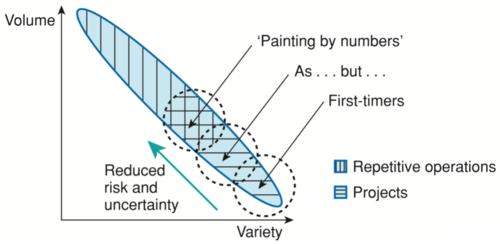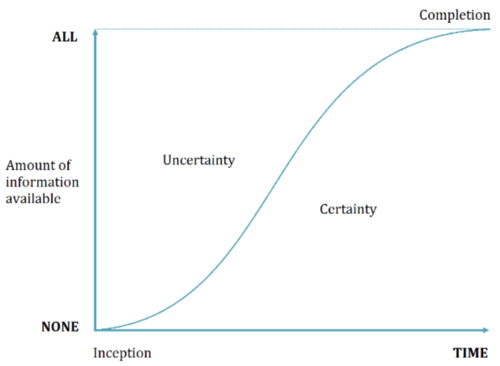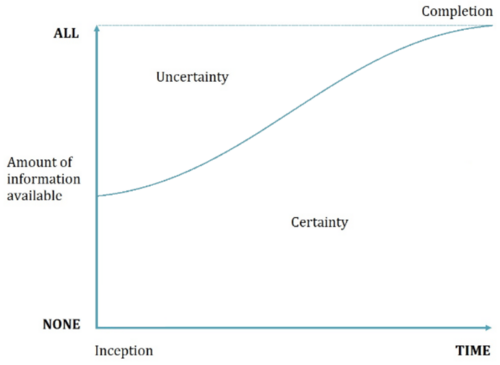Project Uniqueness
Developed by Seyed Habibollah Zohori Bahrami
Contents |
Abstract
Projects are per definition unique. But since some project are more unique than others, how should the project manager decide whether to address and handle the tasks and activities as a project or as a business activity? In other words, how does one distinguish between what is a project and what is not, subject to the uniqueness? This article strives to answer these questions based on a project management model described in Harvey Maylor’s book “Project Management”, where projects are considered as a set of processes that have either high or low variety and volume. Based on their variety and volume, projects are categorized. This article furthermore briefly discusses how the category would influence how the project manager would expect to manage the particular project given the uncertainties and risks affiliated with the projects.
The Big Idea

According to the worldwide federation of national standards bodies, International Organization for Standardization (ISO), a project is defined as:
“A project consists of a unique set of processes consisting of coordinated and controlled activities with start and end dates, performed to achieve project objectives…”. [2]
Furthermore, the Project Management Institute (PMI) defines a project as:
“A project is a temporary endeavour undertaken to create a unique product or service”. [3]
Likewise, many other definitions state that projects are unique, and must have a degree of novelty in terms of time, team carrying out the task or product being provided. Although all projects are per definition unique, the degree of uniqueness of projects differs considerably from project to project. For example, the uniqueness of Elon Musk’s mars colonization project is very much different than the uniqueness of a yearly event management project by DTU. More than much else, it is the uniqueness of a project that frames which tools, models, and theories that are applicable and should be used to successfully manage a project from its commencement to its completion. However, quantifying and assessing the uniqueness of a project is utmost complicated.
Harvey Maylor suggests that one way a project manager can thoroughly determine what is and what is not a (unique) project is by analysing the system of delivery and considering the activities and processes of that particular project instead of the outcome of the project. [1] In other words, the project manager should organise to deliver a project as a process. Subsequently, the project manager should assess each process and classify it. In the classification of processes, the project manager should consider the volume and variety of the processes of that particular project. Here the volume is the quantity of throughputs for that process, and variety is the number of different variations of processes possible. These form an inverse relationship as shown in Figure 1. Based on this figure, processes of a project can either have high or low variety and volume.
- High volume processes have operations/processes that are highly repeatable, for example the processes of a petrochemical plant, whereas low volume processes have operations/processes that are little/slightly repeatable, for example a chauffeur service.
- High variety processes have operations/processes that are very flexible, for example a chauffeur service, because the service has to respond to needs of individual passengers, whereas a low variety processes have operations/processes that are well-defined/standardized, for example a petrochemical process has little flexibility.
According to Maylor’s model of volume versus variety, projects can be classified into three types:
First timers:
In its traditional understanding, project management has processes that have low-volume and high-variety. This means that the processes have low quantity of throughputs and little (or no) repeatability, and high number of different variations of process possible and very flexible/ductile processes. Because of this particular characterisation of processes, a project (in its traditional understanding) is very unique, since the notion uniqueness prevails from precisely this process classification variation. In Figure 1 the projects with very high level of uniqueness are defined as “First-timers”. These are projects that no one has done before, for example the first man walking on the moon, the first message sent between a network of geographical separated computers and the first alternative fuel vehicle. All these projects have processes that have low-volume and high-variety.
As… But…:
Processes that have slightly higher volume and lower variety than the first-timers are also considered as projects. These projects, annotated as “As... but…”, have some similarity to previous work, which could be in terms of either operations/processes followed or products being delivered, however they have some differences. In other words, despite trying to complete the same project with the purpose of obtaining a very similar outcome/product, there will be some alterations such as people being involved, or processes being followed.
Painting by numbers:
A third classification of projects is the “Painting by numbers”, in which processes have mid-high volume (are repeatable) and mid-low variety. The term “Painting by numbers” originates from the art-style system, where a picture is divided into shapes each marked with a number that corresponds to a particular colour, and by painting each shape with that specific colour, a finished painting ultimately emerges. Following that framework, projects in this category have well defined processes and outcomes, and they have high commonality with previous projects. Marketing research is an example of activities in an organization that is considered project-based, but because many aspects of the activities in the marketing research has been done before, it is not considered a very unique project. Because of the high quantity of throughputs in its processes, as well as the repeatability and low number of variations of processes, marketing research is considered a project categorized as “Painting by numbers”.
Business as usual:
At the extreme of the model in Figure 1, where processes have very high volume and very little variety, activities/operations are highly repeatable and inflexible, and are therefore neither considered unique or a project. Examples of such processes are the production of a car and delivery in a post office. These repetitive operations are not considered projects, but rather fall on a category as “Business as usual”, not presented in Figure 1, and not discussed further in this article.
Applications
Applying the volume versus variety model put forth by Maylor is deemed useful for any project-based organization that wishes to analyse the uniqueness of a project. If the processes of a project and their volumes and varieties are assessed prior to project launch, the uniqueness of the project can be evaluated. And based on the uniqueness the correct project manager can be assigned to the project to efficiently and effectively manage the project. In the following, each of the three categories of projects, i.e. “First-timers”, “As... but...” and “Painting by numbers”, are exemplified, it is succinctly explained when they are applicable, and their strengths are briefly assessed.
Very unique projects and decisions:
Combing innovation with project management has progressively become more apparent in project-based organizations, creating consensus in the idea of project management also being about breaking new ground - doing things that have never been done before [4]. Definitionally, these innovative projects fall into the category of unique first-timers. First-timer projects are proven beneficial to organizations, not least because of their value-creating innovative attributes. However, these projects are characteristically unique, which makes them more complex, uncertain and difficult to manage (see Uncertainties in projects). To manage first-timer projects efficiently and effectively, high level of requirements of project management skills, experience, and competencies from the assigned project manager (and the project management team) are deemed a necessity. These projects are therefore often exclusively managed by Project Management Professionals (PMP).
In the category of highly unique first-timer projects, where uncertainty is immense, the project manager is expected to make decisions under uncertainty. This can be very hard for the project manager, because in very uncertain settings, risks are inevitable. While many theories, tools, and models in risk management are to be applied for these types of settings, one “best way” has not been developed. Robust decision-making people, however, can attack these types of settings by the regret decision theory, i.e. instead of maximizing return/value, they minimize regrets [5]. For example, if a project manager does not know how to optimize the net present value for an investment option, he/she can minimize the regret by deciding not to spend more than €10,000,000. This theory is about capping your worst scenario. If the project manager realizes that the investment option will exceed the cost limit, it is rejected.
Learning from similar projects:
In a project-based organization learning from previous projects and applying the knowledge to somewhat similar future projects is vital to ensure success in all phases of a project lifecycle, from its commencement to its completion. “As... but...” projects, that is, as the job we did last time, but with the following differences, are all about utilizing the experience of doing similar projects. There are many benefits affiliated with applying knowledge about previously commenced projects to new ones, such as reducing uncertainty, ensuring higher quality by not falling into the same setbacks, and assigning the right resources from the start. “As… but…” projects are furthermore known for using previous costs as a baseline for future cost-estimation, which is a technique widely practiced amongst project managers.
Process thinking:
Many projects require that several similar or identical operations in a segment of the project is to be applied repeatedly. In other cases, we find that a project that has high commonality with a previously completed project is to be commences. These projects are referred to as “Painting by numbers”. Understanding the uniqueness of these projects, by applying the process-thinking that the volume vs. variety model yield, can be proven remarkably valuable for these types of projects. One example is the companies Yorkon and Britspace, who have taken the process-thinking to heart and adapted it into their core competencies. They have developed modular construction systems for use in fast-food restaurants for the McDonald’s chain [6]. Modular construction is about using pre-engineered volumetric units that are installed on-site as fitted-out and serviced building blocks. Because McDonald’s wanted to expand their outlets for their restaurants, the companies Yorkon and Britspace designed modular constructions for their outlets, building over 300 outlets. After each construction project, the companies improved the process of constructing the modules. A project in Runcorn was completed in just 24 hours from the modules arriving on the prepared site to opening, exceptionally proving the true strength of painting by numbers projects. If each of the 300 outlets were considered a unique first-timer project, the construction of every single outlet may very well have taken several months to complete.
Uncertainties in projects:
The word “project” derives from the latin word “pro-jectae”, meaning “throw forward”. Projects are therefore considered projections into the future, and since the future is uncertain so is the progression of the project [7]. All projects, regardless of their uniqueness, are inherently uncertain. However, unique projects give rise to unique problems yielding to more uncertainty and risks than non-unique projects. According to Luce et al. who researched standard approaches in economics, the uncertainties affiliated with a project is highest at the inception of the project, which directly correlates to the deficiency of the information available [8]. This is illustrated in Figure 2. As the project progresses, information becomes readily more available and uncertainties decrease innately until completion of the project is reached. At the point of completion all information has become available and the uncertainties affiliated with the project have ceased. Figure 2 describes the Certainty vs. uncertainty distribution of unique first-timer projects. Moving away from very unique first-timer projects can be beneficial in an organizational point of view. As the activities/processes in a project becomes more repetitive/routinized, the risks and uncertainties affiliated with the activities/processes will decrease, because habitualization and routinization reduces pervasive uncertainty [9]. In other words, if a project that has high commonality with previous projects is commenced, the amount of information available at the inception of that project is innately higher than the previous projects, because the information of the previous projects are inherited. Figure 3 visualises the Certainty vs. uncertainty distribution of non-unique painting by numbers projects. Evidently from Figure 3, the uncertainties affiliated with non-unique projects are also highest at the inception of the project, because of the deficient amount of information available.
Limitations
In this article, the uniqueness of projects has been assessed by considering the project as a process and analysing the processes by the volume vs. variety model put forth by Harvey Maylor. The strengths of the model have been explained through exemplifications of each of the categories “first-timers”, “as... but...”, and “painting by numbers”, and uncertainties in projects has briefly been explained. While the model helps a project manager to determine what is and what is not a (unique) project, it inevitably has limitations as well. In the following, some of these limitations are explained.
A project that is a first-timer project to you is not necessarily a first-timer project to me
Projects are made by people and for people [7]. Adding the people constraint into the uniqueness of a projects might invalidate the categorization of the three types of projects in Maylors model, because a project that e.g. is a first-timer project to you is not necessarily a first-timer project to me [10]. Each individual has a particular interpretation of the project based on the his/her experience. Because of this experience even a very non-unique project can become unique for the project manager, and vice verca.
“Hedgehog syndrome”
Using previous knowledge as a baseline for future projects has in this article been assessed to be very useful. However, this method assumes that the projects that was previously completed has been reviewed in a meaningful way to develop the project processes and provide feedback to the organisation. Otherwise the so-called hedgehog syndrome will rule. The hedgehog syndrome refers to the inability of project contributors (i.e. hedgehogs) to learn from experiences (i.e. encountering cars while crossing the rode) and utilize their knowledge in a beneficial, for the upcoming project, phase [11]. It is argued that the poor quality of post-project reviews, or entirely absence of these, causes hedgehog syndrome.
Not quantifiable
It is in many cases not possible to quantify the exact volume and the exact variety of processes in a project. Therefore, it is hard to distinguish between the three categories “first-timers”, “as... but...”, and “painting by numbers”.
Annotated bibliography
Maylor, Harvey. “Project Management”. 4th ed. Financial Times Prentice Hall. ISBN 978-0-273-70432-4. Harlow, 2010.
The volume vs. variety model was first presented by Harvey Maylor in this book. While the book is merely considered an introduction to project management, it thoroughly describes many tools, techniques used by best-practice companies to improve their project management performance. The chapters that was used for this article are chapter 1 and 8.
Straw, Gary. “Understanding project management: Skills and insights for successful project delivery”. Kogan Page Publishers, 2015.
Adopting the volume vs. variety model from Harvey Maylor, this book describes the same model in a different visualisation and exemplifies the three categories “first-timers”, “as... but...”, and “painting by numbers”. In the first chapter, the book give insight into the challenge of characterizing projects and project management.
References
- ↑ 1.0 1.1 Maylor, Harvey. “Project Management”. 4th ed. Financial Times Prentice Hall. ISBN 978-0-273-70432-4. Harlow, 2010.
- ↑ ISO-21500, 2013.
- ↑ Project Management Institute, A Guide to the Project Management Body of Knowledge (PMBOK® Guide), 5th Edition, 2013.
- ↑ Gallagher, S. “Time, risk, and innovation: creating space in your day to solve meaningful problems.” Paper presented at PMI® Global Congress 2015—EMEA, London, England. Newtown Square, PA: Project Management Institute. 2015.
- ↑ Geraldi, J., & Oehmen, J. “Don’t maximize value, minimize regret: Simple rules for early opportunity screening in volatile environments.” Poster session presented at MIT System Design & Management Symposium 2018, Cambridge, MA, United States, 2018.
- ↑ Lawson, R. M., et al.. ” Modular Construction using Light Steel Framing: An Architect’s Guide”. The Steel Construction Institute. ISBN 1 85942 096 6. Berkshire, 1999.
- ↑ 7.0 7.1 Geraldi, J., Thuesen, C., Oehmen, J., & Stingl, V.. “How to DO Projects? A Nordic Flavour to Managing Projects: DS-handbook 185:2017.”. Dansk Standard, 2017.
- ↑ Luce, Robert Duncan, and Howard Raiffa. “Games and decisions: Introduction and critical survey.” New York: Wiley, 1958.
- ↑ Becker, Markus C., and Knudsen, Thorbjørn. "The role of routines in reducing pervasive uncertainty." Journal of business research58.6 (2005): 746-757.
- ↑ Straw, Gary. “Understanding project management: Skills and insights for successful project delivery”. Kogan Page Publishers, 2015.
- ↑ Chatzimichailidou, M. et al. ”A conceptual grey analysis method for construction projects”. Management: Journal of Sustainable Business and Management Solutions in Emerging Economies, 20(74), 25-36. Zlatibor, Serbia, 2014.

